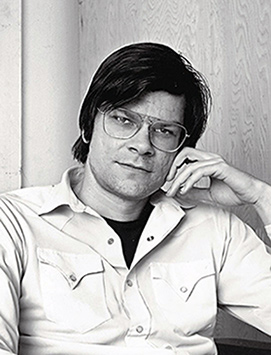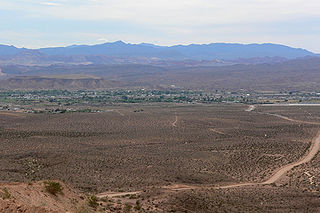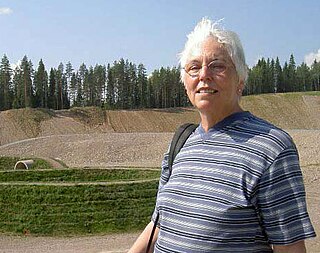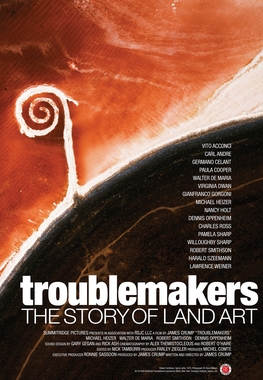
Double Negative is a piece of land art located in the Moapa Valley on Mormon Mesa (or Virgin River Mesa) near Overton, Nevada. Double Negative was created in 1969 by artist Michael Heizer, and consists of a trench dug into the earth.

Double Negative is a piece of land art located in the Moapa Valley on Mormon Mesa (or Virgin River Mesa) near Overton, Nevada. Double Negative was created in 1969 by artist Michael Heizer, and consists of a trench dug into the earth.

The work consists of a long trench in the earth, 30 feet (9 m) wide, 50 feet (15 m) deep, and 1500 feet (457 m) long, created by the displacement of 244,000 tons of rock, mostly rhyolite and sandstone. Two trenches straddle either side of a natural canyon (into which the excavated material was dumped). The "negative" in the title thus refers in part to both the natural and man-made negative space that constitutes the work. The work essentially consists of what is not there, what has been displaced.
Double Negative can be reached by following Mormon Mesa Road north-eastward from Overton to the top of the mesa, continuing across it for 2.7 miles, turning left at the opposite edge onto a smaller path that extends along the rim of the mesa, and then following the path north for 1.3 miles.
In 1969 the art dealer Virginia Dwan funded the purchase of the 60-acre site for Double Negative and in turn, the artist transferred the property deeds to Dwan. In 1971 Heizer prevented the Dwan Gallery from selling the work. Dwan then donated Double Negative to the Museum of Contemporary Art, Los Angeles (MoCA) in 1984, with Heizer’s blessing, to coincide with “In Context: Michael Heizer, Geometric Extraction”. [1] Among the terms of the agreement with the museum is the fact that, according to the artist's wishes, MoCA will undertake no conservation of the piece as Heizer indicated that nature should eventually reclaim the land through weather and erosion. [2] Since then, Heizer has expressed a contrasting wish to restore the piece, perhaps in opposition to Robert Smithson's support for the principle of entropy. [3]
For the solo exhibition "In Context: Michael Heizer, Geometric Extraction", MoCA was able to include a photographic panorama of Heizer’s work. For the large-scale, historical survey of land art “Ends of the Earth” at MoCA in 2012, Heizer did not want any representation of Double Negative to be included in the exhibition. [4] A good aerial photograph appears in the catalogue, but Heizer reportedly worried that documentation in a museum gallery would misrepresent a sculpture that he felt could be known only through physical experience. [5]
In 2021, plans for a solar development project near Double Negative were rejected due to resident protests against the project's impact on the artwork. [6] [7] The work is currently owned by MoCA and is accessible by four-wheel drive vehicle or motorcycle.

Allan Dwan was a pioneering Canadian-born American motion picture director, producer, and screenwriter.

Robert Smithson was an American artist known for sculpture and land art who often used drawing and photography in relation to the spatial arts. His work has been internationally exhibited in galleries and museums and is held in public collections. He was one of the founders of the land art movement whose best known work is the Spiral Jetty (1970).

Land art, variously known as Earth art, environmental art, and Earthworks, is an art movement that emerged in the 1960s and 1970s, largely associated with Great Britain and the United States but that also includes examples from many countries. As a trend, "land art" expanded boundaries of art by the materials used and the siting of the works. The materials used were often the materials of the Earth, including the soil, rocks, vegetation, and water found on-site, and the sites of the works were often distant from population centers. Though sometimes fairly inaccessible, photo documentation was commonly brought back to the urban art gallery.

The Museum of Contemporary Art, Los Angeles (MOCA) is a contemporary art museum with two locations in greater Los Angeles, California. The main branch is located on Grand Avenue in Downtown Los Angeles, near the Walt Disney Concert Hall. MOCA's original space, initially intended as a temporary exhibit space while the main facility was built, is now known as the Geffen Contemporary, in the Little Tokyo district of downtown Los Angeles. Between 2000 and 2019, it operated a satellite facility at the Pacific Design Center facility in West Hollywood.

Michael Heizer is an American land artist specializing in large-scale and site-specific sculptures. Working largely outside the confines of the traditional art spaces of galleries and museums, Heizer has redefined sculpture in terms of size, mass, gesture, and process. A pioneer of 20th-century land art or Earthworks movement, he is widely recognized for sculptures and environmental structures made with earth-moving equipment, which he began creating in the American West in 1967. He currently lives and works in Hiko, Nevada, and New York City.

Overton is a community that is part of the unincorporated town of Moapa Valley in Clark County, Nevada. Overton is on the north end of Lake Mead. It is home to Perkins Field airport and Echo Bay Airport.

ACE Gallery is an internationally recognized art gallery specializing in contemporary art. ACE Gallery Los Angeles is located in the Miracle Mile section of Los Angeles a few blocks east of Museum Row.

City is a land art sculpture by Michael Heizer in Garden Valley, a desert valley in rural Lincoln County in the U.S. state of Nevada. More than a mile long, it is the largest contemporary artwork ever built. It was begun in 1972, took 50 years to complete, and cost an estimated $40 million. City is maintained by the Triple Aught Foundation and opened on September 2, 2022, to limited, reservation-only viewing by a maximum of six visitors per day.

Nancy Holt was an American artist most known for her public sculpture, installation art, concrete poetry, and land art. Throughout her career, Holt also produced works in other media, including film and photography. Since 2018, her legacy has been cared for by Holt/Smithson Foundation.
Buffalo Rock State Park & Effigy Tumuli is an Illinois state park on 298 acres (121 ha) in LaSalle County, Illinois, United States. The park sits across the Illinois River from Starved Rock State Park, just south of the Illinois and Michigan Canal trail. According to legend, it was once used as a "blind canyon" for Indians to capture buffalo. Effigy Tumuli, an art exhibit on the park property, consists of five earth art animal sculptures native to the Illinois River. It was constructed as a tribute to Native American tradition. The park is located 5 miles (8.0 km) east of Utica, Illinois, and approximately 85 miles (137 km) southwest of Chicago, Illinois. Its sandstone bluffs were carved by the Illinois River near the end of the Pleistocene epoch, and now serves as a State Park for local residents and tourists.

Charles Ross is an American contemporary artist known for work centered on natural light, time and planetary motion. His practice spans several art modalities and includes large-scale prism and solar spectrum installations, "solar burns" created by focusing sunlight through lenses, paintings made with dynamite and powdered pigment, and Star Axis, an earthwork built to observe the stars. Ross emerged in the mid-1960s at the advent of minimalism, and is considered a forerunner of "prism art"—a sub-tradition within that movement—as well as one of the major figures of land art. His work employs geometry, seriality, refined forms and surfaces, and scientific concepts in order to reveal optical, astronomical and perceptual phenomena. Artforum critic Dan Beachy-Quick wrote that "math as a manifestation of fundamental cosmic laws—elegance, order, beauty—is a principle undergirding Ross’s work … [he] becomes a maker-medium of a kind, constructing various methods for sun and star to create the art itself."
Virginia Dwan was an American art collector, art patron, philanthropist, and founder of the Dwan Light Sanctuary in Montezuma, New Mexico. She was the former owner and executive director of Dwan Gallery, Los Angeles (1959–1967) and Dwan Gallery New York (1965–1971), a contemporary art gallery closely identified with the American movements of Minimalism, Conceptual Art, and Earthworks.

Levitated Mass is a 2012 large-scale public art sculpture by Michael Heizer at Resnick North Lawn at the Los Angeles County Museum of Art. The installation consists of a 340-ton boulder sculpture placed above a 456-foot viewing pathway to accommodate 360-degree viewing. The nature, expense and scale of the installation attracted discussion within the public art world, and its notable 106-mile transit from the Jurupa Valley Quarry in Riverside County was widely covered by the media.

David Randall Hertz is an American architect, inventor and educator. He is known for his work in sustainable architecture and as an early innovator in the development of recycled building materials.

Star Axis is an earthwork built by American sculptor Charles Ross to observe the stars, which is considered to be a defining example of land art. The roughly eleven-story architectonic sculpture and naked-eye observatory is situated on a mesa in the eastern plains of the New Mexico desert. It incorporates five main elements that include apertures framing several earth-to-star alignments, which allow a visitor to experience them in human scale. Ross conceived the project in 1971, began construction in 1976, and as of fall 2022, had targeted 2025 for its completion. Art historian Thomas McEvilley places the work in the lineage of monuments of archaeoastronomy such as the Great Pyramids, Stonehenge, El Caracol, Chichen Itza and the 15th-century Ulugh Beg Observatory. Curator and writer Klaus Ottmann has described Star Axis as "a summary of Ross's lifelong pursuit of the dynamics of human interaction with light and the cosmos."
Michael Govan is the director of the Los Angeles County Museum of Art. Prior to his current position, Govan worked as the director of the Dia Art Foundation in New York City.

Troublemakers: The Story of Land Art is a 2015 American documentary film directed by James Crump. Troublemakers chronicles the history of land art in the 1960s and 1970s, when a group of radical New York artists began producing earthworks on a monumental scale in the desert spaces of the American southwest. The film follows the enigmatic careers of artists who use the earth itself as their primary medium, including Robert Smithson, Walter De Maria and Michael Heizer.

Mormon Mesa is a mesa between the Virgin River and the Muddy River in Clark County, southern Nevada.

Felipe Pantone is an Argentine-Spanish contemporary artist. He was born in Buenos Aires, Argentina and raised in southeast Spain. Pantone's body of work is based in kinetic art, installations, graffiti, and design, characterized by “use of bold colors, geometrical patterns, and Op Art elements.” His combinations recall “bright colored typography, 80s Synth pop music, and SMPTE color bars on the TV.”
Clarissa Tossin (born 1973) is a visual artist from Brazil and based in Los Angeles. Her collaborative, research-based practice develops alternative narratives found in the built environment, using elements of installation, sculpture, and moving image to explore intersections of place, history, and aesthetics.